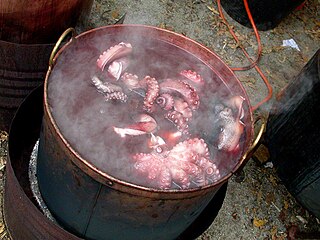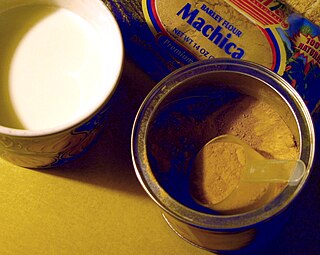
Guava is a common tropical fruit cultivated in many tropical and subtropical regions. The common guava Psidium guajava is a small tree in the myrtle family (Myrtaceae), native to Mexico, Central America, the Caribbean and northern South America. The name guava is also given to some other species in the genus Psidium such as strawberry guava and to the pineapple guava, Feijoa sellowiana. In 2019, 55 million tonnes of guavas were produced worldwide, led by India with 45% of the total. Botanically, guavas are berries.

Santander is a department of Colombia. Santander inherited the name of one of the nine original states of the United States of Colombia. It is located in the central northern part of the country, borders the Magdalena River to the east, Boyacá to the south and southeast, the Norte de Santander Department to the northeast, the Cesar Department to the north, the Bolivar and Antioquia Departments to the west. Its capital is the city of Bucaramanga.

An alfajor or alajú is a traditional confection typically made of flour, honey, and nuts. It is found in Argentina, Bolivia, Paraguay, the Philippines, Southern Brazil, Southern France, Spain, Uruguay, Peru, Ecuador, Colombia and Chile. The archetypal alfajor entered Iberia during the period of al-Andalus. It is produced in the form of a small cylinder and is sold either individually or in boxes containing several pieces.

Panela or rapadura is an unrefined whole cane sugar, typical of Latin America. It is a solid form of sucrose derived from the boiling and evaporation of sugarcane juice. Panela is known by other names in Latin America, such as chancaca in Chile, Bolivia, and Peru, piloncillo in Mexico. Just like brown sugar, two varieties of piloncillo are available; one is lighter (blanco) and one darker (oscuro). Unrefined, it is commonly used in Mexico, where it has been around for at least 500 years. Made from crushed sugar cane, the juice is collected, boiled, and poured into molds, where it hardens into blocks. It is similar to jaggery, which is used in South Asia. Both are considered non-centrifugal cane sugars.

A Swiss roll, jelly roll, roll cake, cream roll, roulade or Swiss log is a type of rolled sponge cake filled with whipped cream, jam, icing, or any type of filling. The origins of the term are unclear; in spite of the name "Swiss roll", the cake is believed to have originated elsewhere in Central Europe, possibly Austria or Slovenia. It appears to have been invented in the nineteenth century, along with Battenberg cake, doughnuts, and Victoria sponge. In the U.S., commercial snack-sized versions of the cake are sold with the brand names Ho Hos, Yodels, Swiss Cake Rolls, and others. A type of roll cake called Yule log is traditionally served at Christmas.

A fruit butter is a sweet spread made of fruit cooked to a paste, then lightly sweetened. It falls into the same category as jelly and jam. Apple butter and plum butter are common examples, but fruit butters can be made from any firm fruit. Fruit pastes, such as quince cheese are popular in Latin American countries, are similar but more highly sweetened and jelled. They are sold in shallow tins or as wrapped bricks, while fruit butters usually come in wide-mouthed jars and are more common in Central and Eastern Europe.

Colombian cuisine is a compound of the culinary traditions of the six main regions within Colombia. Colombian cuisine varies regionally and is particularly influenced by Indigenous Colombian, Spanish, and African cuisines, with slight Arab influence in some regions. As one of the most biodiverse countries in the world, Colombia has one of the widest varieties of available ingredients depending on the region.

Manjar blanco, also known as manjar de leche or simply manjar, is a term used in Spanish-speaking areas of the world in reference to a variety of milk-based delicacies. In Spain the term refers to blancmange, a European delicacy found in various parts of the continent as well as the United Kingdom. In the Americas it refers to a sweet, white spread or pastry filling made with milk. This term is sometimes used interchangeably with dulce de leche or cajeta in Latin America but these terms generally refer to delicacies prepared differently from those just described. Related dishes exist by other names in other regions, such as tembleque in Puerto Rico. In Portuguese-speaking countries the dish is known as manjar branco.

Colombian Americans, are Americans who have Colombian ancestry. The word may refer to someone born in the United States of full or partial Colombian descent or to someone who has immigrated to the United States from Colombia. Colombian Americans are the largest South Americans Hispanic group in the United States.
Quesillo refers to different Latin American, Spanish, and Filipino foods or dishes depending on the country:

Pulpo a Feira - 5 pasos para hacer una receta deliciosa Pulpo a Feira

Aguapanela, agua de panela or agüepanela is a drink commonly found throughout South America and a few parts of Central America and Caribbean. Its literal translation means "panela water" as it is an infusion made from panela which is derived from hardened sugar cane juice.

Goiabada is a conserve made of red guavas and sugar, commonly found throughout the Portuguese-speaking countries of the world. It dates back to the colonial times of Brazil, where guavas were used as a substitute for the quinces used to make quince cheese. It required an abundance of sugar and slave labor for its production as it was made in large batches within cauldrons cooking over a slow fire. In rural areas of Brazil, it is still commonly made at home for family use or sale.

Natillas is a term in Spanish for a variety of custards and similar sweet desserts in the Spanish-speaking world. In Spain, this term refers to a custard dish made with milk and eggs, similar to other European creams as crème anglaise. In Colombia, the delicacy does not include eggs, and is called natilla.

Quince cheese is a sweet, thick jelly made of the pulp of the quince fruit. It is a common confection in several countries.
Día de muertos, also known as Día de difuntos and Los hijos de la guayaba, is a 1988 Mexican comedy-drama film directed by Luis Alcoriza. It is Alcoriza's penultimate film as director and his last one made entirely in Mexico; his last film directed, La sombra del ciprés es alargada, was a Mexican-Spanish co-production.

Paraguayan cuisine is the set of dishes and culinary techniques of Paraguay. It has a marked influence of the Guaraní people combined with the Spanish cuisine and other marked influences coming from the immigration received by bordering countries such as Italian cuisine and German cuisine. The city of Asunción is the epicenter of the distinctive gastronomy that extends in current Paraguay and its areas of influence, which is the reason why is considered the mother of the gastronomy of the Río de la Plata. It is worth clarifying that in the Paraguayan society, the exchange of knowledge between mestizos, creoles and cario-guaraní people occurred before the Jesuit missions.

Pinol or piñol is a traditional hot beverage of Ecuador, made from máchica and panela mixed with spices and combined with liquid, usually milk. The term pinol may also refer to the dry mix itself.

Carolina Cruz Osorio is a Colombian journalist, tv host, model, businesswoman and beauty pageant titleholder who represented her country at Miss International 2000 where sheplaced Top 15.
















